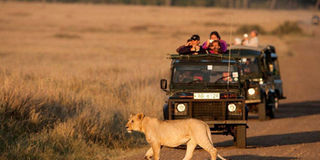Big five safaris keep Kenya on the forefront

Tourists at a local game park watch as a lion, one of the Big Five crosses a path. Wildlife safaris are Kenya’s single major attraction. Apart from the wildebeest migration Maasai Mara game reserve is known for, the park has all the big five greatest wild animals including the lion, leopard, elephant, buffalo and rhino. This makes it the most popular tourist destination in Kenya. PHOTO/FILE
What you need to know:
- Tourists from different parts of the world visit Kenya to see either wildlife or other natural resources.
- Lake Nakuru is slowly recovering from several environmental pressures that caused its flamingo population to decline in the 1990s.
- Five national parks have been classified as offering The Big Five safaris that have kept Kenya on the forefront when it comes to bringing in revenue.
By FAITH NYAMAI
Kenya’s incomparable natural beauty has made it one of the world’s tourist havens.
Known for its diversity of landscape, wildlife and cultures, the country is Africa’s original Safari destination that has attracted explorers, adventurers and travellers for centuries.
Tourists from different parts of the world visit Kenya to see either wildlife or other natural resources.
The country’s forests, high plains, moorlands, lush grasslands mountain slopes and semi-deserts provide an amazing range of habitat for the full collection of East African wildlife.
Safari destination
Foreigners with an opportunity to visit Kenya find a wide choice for their holidays and adventure.
Since 1960s, Kenya has been the most popular safari destination in Africa.
The good network of international flights has made it possible and easier for tourists to move from one park to another.
Kenya does not only offer enormous wildlife safaris, but is also home to peoples of more than 40 different cultures, with their own languages, music and traditional dress.
While tourists come to watch wildlife, they are also attracted by the diverse traditional cultural practices that are widely demonstrated by different communities.
Although the country does not offer purely cultural safaris, tourists are most likely to experience captivating encounters with the various Kenyan tribes in their host communities.
Despite the rising competition from Tanzania, South Africa, Zambia and Namibia, the country’s diverse wildlife and magnificent landscapes continue to attract hundreds of thousands of tourists every year.
Wildlife safaris are Kenya’s single major attraction. Five national parks have been classified as offering The Big Five safaris that have kept Kenya on the forefront when it comes to bringing in revenue.
Maasai Mara game reserve is the most popular destination in the country. Apart from the wildebeest migration it is known for, the park has all the big five greatest wild animals including the lion, leopard, elephant, buffalo and rhino.
In some seasons, it may be hard to find the rhinos and leopards but elephants, lions and buffaloes are found throughout the year.
The surrounding community has been known for offering cultural tours which really add to the experience.
One of the advantages of the park is that, it has a wide space with accommodation for the tourists although some times the number of tourists may overflow. The park is estimated to host at least 100 lodges and camps.
Amboseli National park is the second most popular national park after the Maasai Mara.
It lies just next to Mt Kilimanjaro making it a perfect destination for wildlife.
Although the park experiences one of the worst droughts, causing the deaths of many animals, all the big five animals are found and especially a large number of elephants make Amboseli a tourist attraction.
Pink carpet
Amboseli is home to more than 50 mammal species and over 400 bird species.
Another destination is the Lake Nakuru National Park, which hosts hundreds of bird species the most common being the flamingos.
The birds cover the surface of the lake giving it a pink carpet-like appearance when viewed from a distance.
It is also a sanctuary for the endangered black and white Rhinos, leopards, gazelle, hyrax, lions, warthogs, monkeys, baboons, giraffe, hippo and ostrich.
Lake Nakuru is slowly recovering from several environmental pressures that caused its flamingo population to decline in the 1990s.
Samburu Game Reserve is characterized by very unique animals one cannot find in any other park in the country.
The animals include Gravy’s Zebra, reticulated giraffes, Kudu, Somali ostriches and the gerenuk although other animals like lions, elephants, cheetahs and leopards are also found there.
Unlike Maasai Mara, Amboseli and Lake Nakuru, Samburu does not have many visitors.
It has an exclusive calmness of its kind. The park experiences some insecurity that causes it to remain closed to tourist sometimes.
Tsavo National Park is the biggest national park in Kenya. It is consists the Tsavo East and the Tsavo West national parks.
While on the beach at the coastal area, the park is ideal to tourists who enjoy a brief wildlife safari. It is popular for its fierce lions referred to as “man eaters of Tsavo”.
It is the home of red skinned elephant herds, black rhinos, leopards, giraffes, hippos and hundreds of other animals.
Sometimes the population of elephants is threatened by poachers, however the vice is not as bad as it was in the 1980s as government efforts to counter it are paying off.
Tsavo East is less developed than Tsavo West but more accessible.
In Tsavo West, elephants can be watched bathing among the hippos.
Other parks are the Mount Kenya national reserve which is the second highest peak in Africa. It is home to rare species of animals as well as spectacular lakes.


